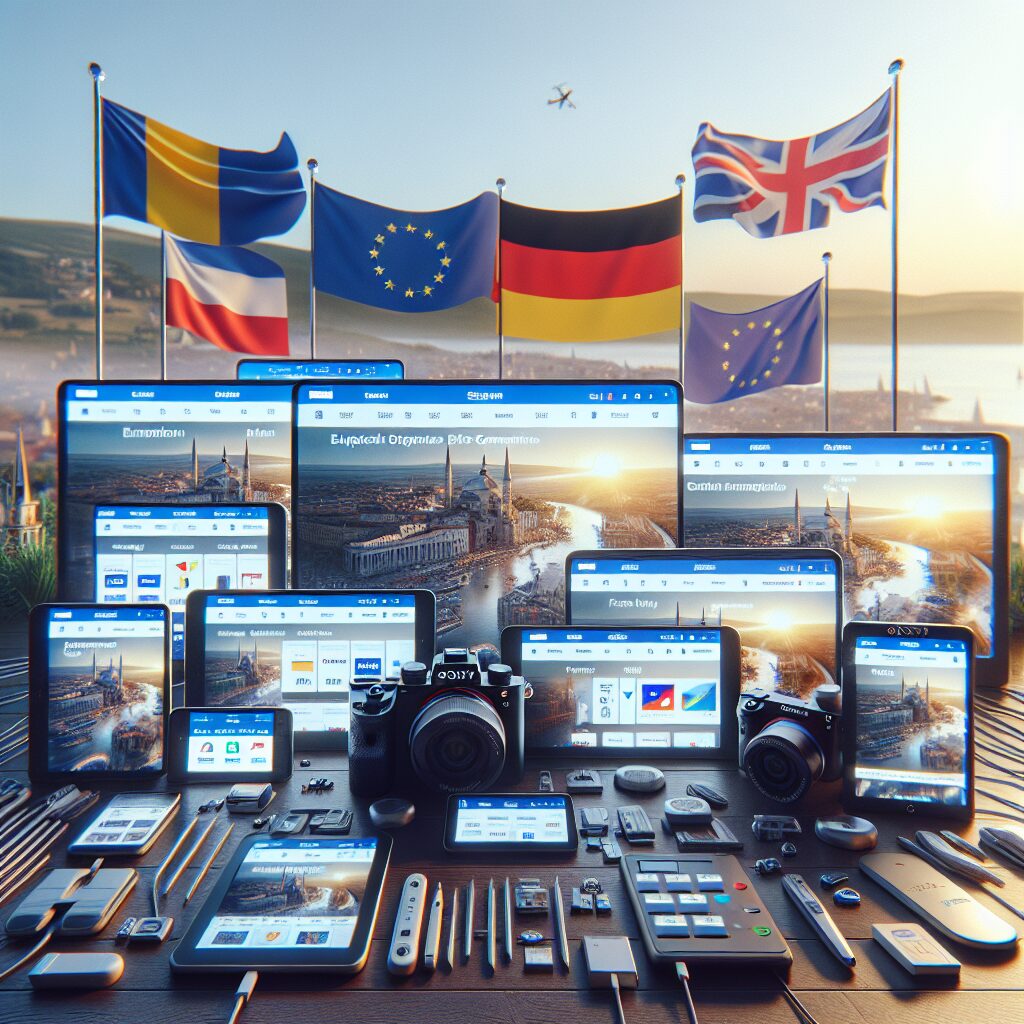About eldris
Clone.Eldris.ai empowers brands to instantly replicate and translate their websites for seamless global expansion. Our automated system delivers SEO-friendly, multilingual clones that launch in days, not months.
In This Article
- Website translations directly impact conversion rates and consumer trust in the EU market.
- German, French, Italian, Spanish, and Dutch are high-priority EU languages for localisation.
- SEO performance improves significantly with properly structured multilingual websites.
- Automated translation tools reduce operational workload and accelerate speed-to-market.
- Compliance with local laws strengthens brand reputation and minimises legal risks.
- Culturally aware UI and product copy enhance the overall shopping experience.
- Translation plugins like Weglot and Langify are ideal for Shopify stores expanding into the EU.
- DIY translations often miss important SEO and brand alignment factors.
- Impact metrics like bounce rates, session duration, and conversion rates help measure ROI.
Why Translate Your Website for the EU Market?
Understanding the EU e-commerce potential
The European Union represents one of the most lucrative e-commerce markets in the world. With a digitally-savvy population of over 447 million and robust logistics infrastructure, tapping into this market is a logical step for growing businesses. However, to maximise your visibility and conversion potential, investing in high-quality website translations is not just beneficial—it is necessary.
English may be widely understood in Europe, but data consistently shows that consumers overwhelmingly prefer to engage and purchase from online stores in their native language. According to a Common Sense Advisory report, 76% of online buyers are more likely to purchase from websites in their own language. Therefore, failing to localise your content can directly result in reduced brand trust and lost revenue opportunities.

Top Languages for EU Website Localisation
Targeting major EU economies by language
When prioritising website translations, begin with the most commercially significant and widely spoken languages in the EU. These include German, French, Italian, Spanish, and Dutch. Germany, in particular, is Europe’s largest e-commerce economy, and over 95% of its population prefers content in German. Similarly, France and Italy offer substantial online shopping potential, but shoppers strongly favour native-language communication.
Don’t overlook smaller, high-income economies such as the Netherlands and the Nordics. Dutch consumers demand native content, and while Scandinavian countries have high English proficiency, offering Norwegian, Danish, or Swedish versions can significantly increase trust. Moreover, consider local variations such as Belgian French vs. Parisian French or Austrian German, which may influence cultural tone and phrasing.
“65% of Europeans rarely or never purchase from English-only websites. Website translations are now a de facto requirement for EU success.”
Benefits of Automated Website Translations
For businesses with tight turnaround times or limited localisation budgets, automated website translations provide a fast, scalable solution. Advanced AI-driven platforms such as DeepL and Google Translate now offer far superior linguistic accuracy compared to earlier iterations. When combined with post-editing by human experts, this hybrid approach balances speed, cost-efficiency, and quality assurance.
Automation allows for real-time translation updates, ensuring that newly added products or changes to the user interface are immediately reflected across all language versions. This agility is particularly important for fast-moving e-commerce environments where promotions, seasonal items, and limited-time deals rotate frequently.
Additionally, many automated localisation tools now integrate seamlessly with CMS and e-commerce platforms like Shopify, WooCommerce, and Magento, reducing developer workload and enhancing operational continuity.
SEO Advantages of Multilingual Content
Multilingual websites significantly enhance your site’s visibility in international Google search results. Implementing website translations properly allows your store to appear in local search engine results pages (SERPs), giving you a direct line to consumers actively searching in their native languages. This market specificity improves organic ranking, click-through rates, and ultimately conversions.
It’s vital to optimise each language version as a separate web entity—ideally using hreflang tags, geo-specific meta tags, and translated URLs when applicable. Also, avoid direct content duplication. Google’s algorithm detects and may penalise sites for mirrored content without substantial value differentiation. Thoughtfully translated and optimised pages tell Google that your content is tailor-made for each local audience.
Moreover, multilingual content contributes positively to dwell time and engagement metrics. Users are more likely to explore your site deeper when they can intuitively navigate it in their preferred language. This user behaviour feedback loop further reinforces your SEO standing.
Compliance and Trust Across EU Member States
The digital landscape in the EU is heavily regulated under frameworks such as the General Data Protection Regulation (GDPR), the Digital Services Act (DSA), and geo-blocking regulations. Presenting your website in the user’s native language helps reinforce your brand’s credibility and shows a respect for local laws and consumer rights.
Displaying key transactional and trust-building information—like privacy policies, checkout flow, and return terms—in the local language significantly boosts user confidence and reduces legal liabilities. Localised cookie consent banners, T&C pages, and customer support links are all part of building a compliant and trusted digital presence in the EU.
Furthermore, some countries have specific language-related legislation. For instance, in France, the Toubon Law requires businesses to display consumer information in French. Non-compliance could result in fines or market restrictions. Quality website translations prevent such legal pitfalls.
Tips for Localising Product Copy and UI
Localising your user interface and product descriptions goes beyond simple direct translation. It involves cultural adaptation, context refinement, and design considerations. For example, be mindful of text expansion during translation. German phrases, for instance, can be up to 40% longer than their English equivalents, which may disrupt UI layouts if not pre-planned.
Consider regional idioms, date/time formats, sizing units, currencies, and payment methods. Integrating local payment options like iDEAL in the Netherlands or Bancontact in Belgium can substantially enhance conversion rates. Colours, images, and even product names may need to be adapted to avoid cultural faux pas or ineffective communication.
Use A/B testing to determine how different audiences interact with localised versions of your CTA buttons, banners, and UI elements. These insights will allow you to double down on what resonates with each region’s buyer psychology.
Best Tools and Plugins for Shopify EU Expansion
Shopify offers robust support for internationalisation through its native multi-language capabilities (Shopify Markets) and third-party plugins. Leading translation solutions like Weglot, Langify, and Translate & Adapt are designed to integrate directly with Shopify and simplify the localisation process.
Weglot stands out due to its automatic detection and translation of all Shopify content, including dynamic and hard-coded sections. Langify offers deeper manual control and customisable translation workflows, suited for businesses seeking detailed oversight. Shopify’s own Translate & Adapt app, launched recently, supports up to 20 languages with auto-translation and manual overrides, ensuring both agility and control.
Additionally, leveraging Shopify’s geolocation app enables user redirection based on browser language or IP address, providing a seamless multilingual experience from the first interaction. Numerous resources are also available through Learn more about Multilingual E-commerce Expansion to guide you through the intricacies of multilingual Shopify storefronts.
Common Pitfalls in DIY Translation Workflow
Although the DIY approach may seem cost-effective initially, it is fraught with risks that can sabotage your EU expansion. One of the most common mistakes is relying entirely on machine translation without proofreading, which often results in awkward phrasing and off-brand messaging. Such linguistic faux pas damage your credibility and may even alienate potential customers.
Another frequent oversight is neglecting SEO elements during translation. Merely translating on-page content without adapting metadata, alt text, URL structures, and heading tags means you’re missing a key part of the localisation strategy. Also, inconsistent terminology across pages and sloppy UI labels can frustrate users and drive bounce rates up.
Finally, businesses often underestimate the time and resources needed to maintain multi-language sites. Without centralised translation management tools, keeping content aligned across languages becomes a logistical nightmare. That’s why integrating with trusted localisation platforms and engaging professionals is not an optional luxury—it’s a necessity for sustainable growth. For more detailed error-prevention techniques, check out Read a related article.
How Long Does It Take to Launch in a European Market?
The timeline for launching in an EU market depends on the complexity of your site, your chosen localisation approach, and the number of target languages. A basic Shopify storefront with fewer than 50 products can achieve accurate and fully compliant localisation in as little as two to four weeks using automated tools and expert editing.
For larger e-commerce operations—especially with extensive product catalogues, bespoke UI architecture, and multi-regional fulfilment—the timeframe expands considerably. A phased rollout is often recommended. Begin by localising top-selling products and priority pages, then scale to full-site coverage based on performance data and ROI indicators.
Remember, it’s not just about translation. Market-specific adaptations, testing, compliance checks, and marketing alignment must also be accounted for in your project timeline. Partnering with localisation agencies or established SaaS solutions can simplify your workflow and help you meet tight time-to-market objectives. One excellent marketplace overview of services can be found at Strategies for European website market entry.
Measuring Impact and ROI of Localised Sites
Once your localised EU website goes live, tracking ROI is critical. While revenue growth is an obvious metric, deeper insights come from observing user behaviour across language versions. Look at local bounce rates, session duration, cart abandonment, and country-specific conversion rates.
Use these metrics to inform future optimisations. Tools such as Google Analytics 4, Hotjar, and Semrush can provide data segmentation by region and language. Regular A/B testing will help uncover which localised elements are performing best—whether it’s CTA phrasing, product titles, or payment methods.
Also factor in indirect benefits such as reduced customer support inquiries, higher trust signals, and improved email marketing engagement. Taking a comprehensive ROI view ensures the long-term sustainability and scalability of your multilingual strategy. For benchmarking standards and regional data points, visit EU regulatory compliance for sellers explained.
Next Steps to Fast-Track Your EU Strategy
Implementing a successful EU market entry via website translations is not a one-time project, but an ongoing strategic initiative. Start by conducting a localisation readiness audit. Determine which countries offer your best product-market fit, then align internal resources toward priority languages.
Choose tools that integrate seamlessly into your existing tech stack and provide scalability. Automate where possible, but never compromise on review quality. Build trust with your target audiences through culturally attuned content, and stay compliant with regional laws. Remember—the faster you localise, the faster you monetise.
Finally, remain agile. Consumer behaviours, legislations, and digital standards evolve. A responsive internationalisation approach keeps you ahead of the curve while competitors hesitate.
Conclusion
[CONCLUSION_CONTENT]
Great guide on website-translations-eu-market-entry-fast-track-your-store – Community Feedback
How can website translation help me enter the EU market quickly?
Automated website translation accelerates EU market entry by replicating your store in local languages, ensuring compliance, and boosting trust—so you can start selling in days, not months.
Which languages are essential for reaching EU customers?
Focus on French, German, Spanish, and Italian to cover most EU e-commerce markets, adapting your website for each audience to maximise reach and conversions.
How do automated translations impact SEO for EU stores?
Automated translations with SEO-friendly structure improve visibility on European search engines, driving organic traffic and sales in new markets when paired with proper technical localisation.










